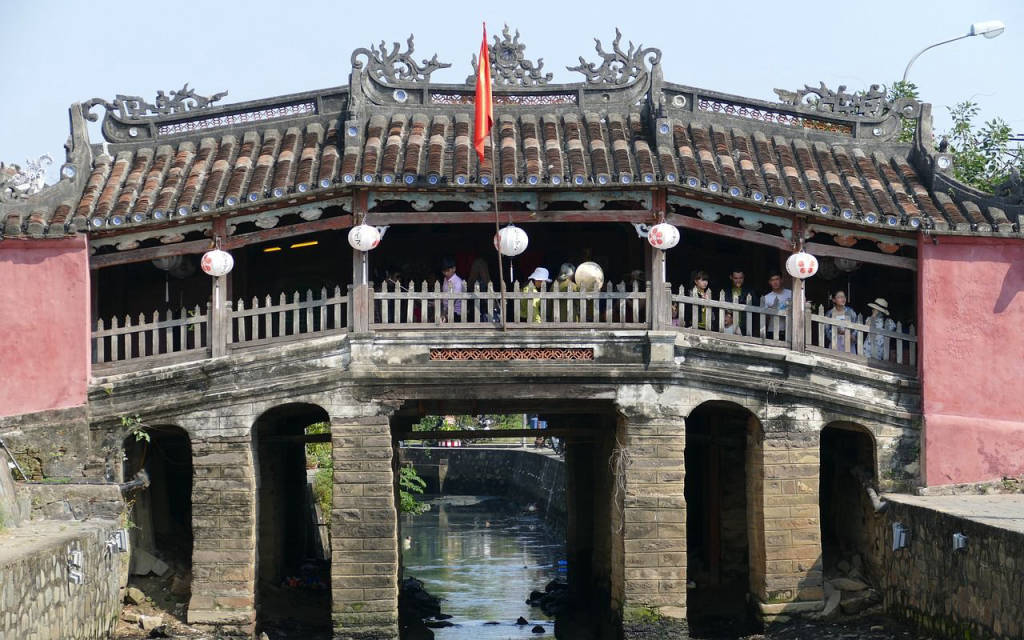Chua Cau - The Japanese Covered Bridge, is a famous symbol of Hoi An, built in the 16th century by Japanese merchants. The bridge has a unique architecture, combining Japanese - Vietnamese - Chinese styles, with yin-yang tiled roofs and sophisticated carvings. This is not only a national historical site but also an attractive check-in point, attracting tourists from all over.
Chua Cau – The Famous Symbol and Pride of Hoi An
Let's explore a famous symbol and pride of the ancient town of Hoi An: Chua Cau (Japanese Covered Bridge) – a bridge that not only holds unique architectural value but also embodies deep historical and cultural stories.
1. History of Chua Cau – Mark of an International Trading Port
Chua Cau, also known as the Japanese Covered Bridge, was built in the late 16th and early 17th centuries by Japanese merchants living and trading in Hoi An. This was a period when Hoi An was a bustling international trading port, a melting pot of Vietnamese, Japanese, Chinese, and Western cultures. The Japanese built this bridge to connect their residential area with the Chinese quarter on the other side of the river. They not only aimed to facilitate trade but also hoped that the bridge would bring peace and prosperity to the entire district. Over more than 400 years, Chua Cau has undergone many renovations but still retains its unique features, standing as a testament to the harmonious blend of cultures in Hoi An.
2. Unique Architecture – A Pinnacle of Cultural Fusion Art
Architecturally, Chua Cau is a unique combination of Japanese, Chinese, and Vietnamese styles.
The Bridge Section
• Chua Cau is 18 meters long, built entirely of precious wood with yin-yang roof tiles. The bridge spans a small branch of the Hoài River. The foot of the bridge consists of sturdy stone pillars that support the entire structure through many flood seasons.
• Walking on the bridge, visitors will feel the smooth wooden floor, polished by the footsteps of millions of tourists. The balustrades are intricately carved with wave motifs, symbolizing the wish for peace and safety from the water.
The Temple Section
• Unlike typical temples, the temple here does not worship Buddha but Bắc Đế Trấn Vũ, the deity who protects residents from floods and natural disasters. The deity's statue is placed in the center of the temple, solemn and simple.
• The temple roof curves softly, decorated with dragon and cloud carvings – two motifs rich in Eastern culture. Notably, the roof is tiled with yin-yang tiles, symbolizing the balance of yin and yang, the harmony of heaven and earth.
The Temple Gate
• The main gate of Chua Cau is adorned with ancient Chinese characters, notably the inscription "Lai Viễn Kiều" – which means "Bridge of Friends from Afar." This is Hoi An's warm welcome to merchants and visitors from around the world.
3. Legend of Chua Cau – The Guardian Myth
Did you know that Chua Cau is also associated with a fascinating and mystical legend? According to folklore, beneath the earth stretching from Japan, through Hoi An to India, there is a giant monster called Cù. Its head is in Japan, its body in Vietnam, and its tail in India. Whenever this monster moves, the lands it passes through experience earthquakes and floods, disrupting the lives of the people. To "tame" this monster, the Japanese built Chua Cau right at the location of its body. Two stone guardians, a dog and a monkey, were placed at the ends of the bridge as protective deities, ensuring peace. Interestingly, Chua Cau was started in the Year of the Monkey and completed in the Year of the Dog. Therefore, these two guardians not only serve as protective symbols but also as historical markers, reminding people of the bridge's construction years.
4. Cultural and Spiritual Values
Chua Cau is not just an architectural work but also a site for important ceremonies of the people of Hoi An, such as peace prayers, rain and wind blessings, and especially the worship of Bắc Đế Trấn Vũ on major festivals. Additionally, Chua Cau is a symbol of unity and harmony between different ethnic groups. The cultural fusion of Japan, China, and Vietnam here has created a diverse and unique Hoi An today.
5. Must-See Photography Spots
Dear visitors, Chua Cau is not only historically significant but also one of the best photo spots in Hoi An.
• From afar: Chua Cau stands out amidst the poetic Hoài River, especially in the evening when lantern lights are lit, reflecting shimmering images on the water.
• View from the bridge: From here, you can enjoy a panoramic view of the ancient town with moss-covered roofs and small boats drifting on the river.
• Architectural details: The intricate carvings, wooden pillars, and moss-covered roof tiles provide the perfect backdrop for creating quintessential Hoi An photos.
6. Conclusion
Dear visitors, Chua Cau is not just a historical monument but also the soul, the enduring symbol of Hoi An – a UNESCO World Heritage Site. Walking across this bridge is not just crossing an architectural structure, but also stepping into a part of history, a convergence of cultures, and fascinating mystical stories. We hope that today's visit will leave you with unforgettable memories.
 Register
RegisterSign in Travel Agent
Sign in Supplier
Sign in Affiliate
Sign in Guru



 P. Minh An, Thành phố Hội An, Tỉnh Quảng Nam, Việt Nam
P. Minh An, Thành phố Hội An, Tỉnh Quảng Nam, Việt Nam